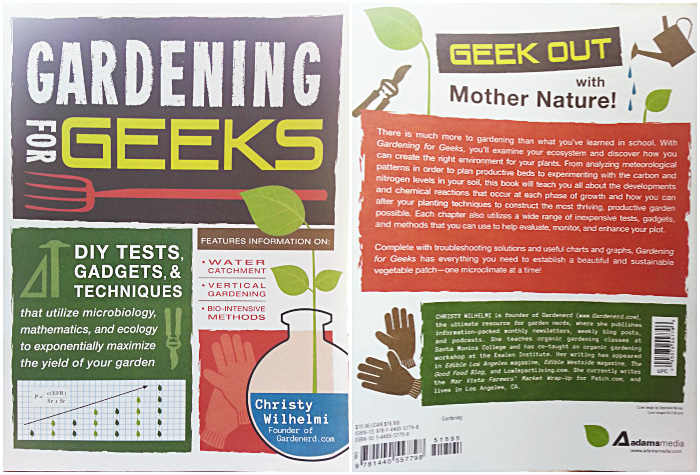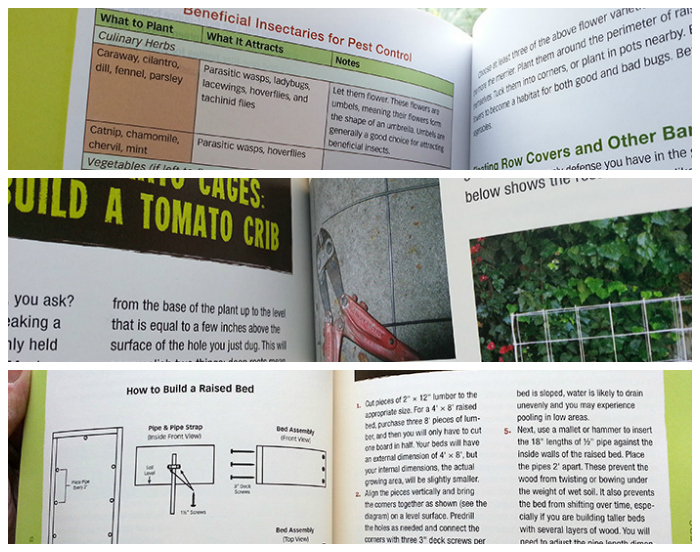
It’s spring and I’m getting antsy about starting our garden! We’ve been growing our veggies and herbs in the raised beds that Super G built two years ago and I’m excited to see what does well this year (if I can keep the chickens and the cat out of the beds!). So when I was offered the chance to review a new gardening book, “Gardening For Geeks,” I said of course. Reading about gardening may not be the same as actually gardening but it’s a great way to get ideas, tips and prep for the growing season.
Founder of the GardenNerd.com website, author Christy Wilhelmi loves to share her organic gardening knowledge on her site, it’s a great resourse filled with free recipes, information and advice on gardeing organically. She specializes in small-space, organic vegetable garden design and holds regular organic gardening classes in California. You may also be very inspired knowing that nearly 70-80% of her family’s produce comes from her garden of less than 200 square feet! You really can pack a lot of good stuff into a small space!
In her book, Gardening for Geeks, Christy helps us discover how to give our plants the right environment — that means learning a bit about meteorology, experimenting with the levels of carbon and nitrogen in our soil and how to adapt the way we plant our gardens by using techniques that allow for the healthiest happiest garden we can create!

I’m no gardening expert and I’m certainly not a very scientific person but I found Gardening For Geeks to be a great book for both beginners and advanced gardeners. There are many great tips and projects in aptly entitle sections of the book — Creating Your Garden Ecosystem (includes how to build a swarm box to attract beneficial bees to your garden!), Garden Beds (with plans to build raised beds), All About Soil, Planning Your Garden Season (includes info on companion planting, starting a worm bin and frost dates), Small Space and Urban Gardening, Planting Nitty Gritty (includes in depth section on heirloom, pollinated and hybrid seeds), Irrigation, Keeping Order, Trellises and Cages for Crops (great instructions for building a big tomato crib and chart that pairs plants with the ideal trellises), Pest Control (love the detailed chart that explains how to tell what pests you’re dealing with by looking at plant damage), Now Pick It! (And Then What!) (talks about how to preserve your food and even includes a few tasty recipes), Browns and Greens for Your Compost Bin (handy section on just what you can put in your pile!), Trusted Seed Companies (really nice list of natural and organic seed catalog companies), Mounds: Naturally Raised Beds.
Along with the detailed information in each section, scattered throughout there are also really cool “Geeky Gardening Tips,” like How to keep critters out of your compost. We also get to go on a “Field Trip” to an aquaponics Farm and an Ecology Action Test Farm.
All in all, I think this is a really nice book for the garden enthusiast to add to their reference material. It is an enjoyable read with tons of useful and helpful info!
Check out Christy Wilhelmi’s Top 5 Reasons To Plant A Garden!
In today’s world of processed foods, pollution, and pink slime, you might be wondering how to ensure that what your family is eating is healthy. Buying organic is a great start, but growing it yourself opens doors to tremendous possibilities. Here’s why:
- Avoid Pesticides – Conventional agriculture uses petroleum based chemicals to combat pests in the field, which not only damages the environment, but destroys important soil microbes that help plants grow. In your own garden, you can plant a diverse range of produce, instead of growing acres of one thing. This cuts down on pest attacks and can even attract beneficial insects to the garden to handle your pest problem for you. You can choose organic means of pest control, like soap sprays, hand-picking (the best pest control tool is your hands, after all) or other methods that don’t leave harmful residues on your food.
- No-GMO Zone – GMOs (genetically modified organisms) or GE (genetically engineered) crops are everywhere you turn. 90% of soy and corn grown in the US is GE. As of this writing, GMO seed is not available to the home gardener, only commercial growers, though companies are trying to legalize GMO corn for home growers as we speak. Growing seeds that are heirloom or open pollinated ensures that those seeds are not genetically engineered, nor can they be patented by corporate seed companies. Buying seeds from companies who sign the Safe Seed Pledge goes further to make sure the seeds they sell have are not GE.
- Get Outside – Kids and adults alike spend much of their free time glued to the TV or computer. Planting a garden gets everyone outside. Gardening provides exercise, and helps kids learn where their food comes from. Adults can learn a thing or two as well. Dive into the wonders of growing and harvesting potatoes. Watch beans climb their poles and flower into fruit. Learn about the evolution of sweet corn or the science behind composting. It’s fascinating stuff!
- Lose the Lawn – Many states are being ravaged by drought, and yet we still throw water away every day by watering grass. Can you eat it? Not unless you’re a cow or goat. Vegetable gardens use water wisely to produce food for your family. Using drip irrigation and sustainable methods to capture water on site will put your water to a more valuable use, and you’ll reap the benefits at your dinner table.
- Get Secure – Food security has become an issue for many who’ve lost their jobs, experienced rising prices, and especially for those living in “food deserts” where fresh produce is scarce. Planting a garden puts food at your finger tips. $1 worth of seeds can grow hundreds of dollars worth of tomatoes, lettuces, and other nutritious vegetables. Since most food travels 1,500 miles to get to consumers, growing your own food shortens the distance and saves gas and energy too.
*reprinted with permission
Where to purchase and how to stay in touch!
The book retails for $15.95 and is available on GardenNerd.com and you can also find Gardening for Geeks: DIY Tests, Gadgets, and Techniques That Utilize Microbiology, Mathematics, and Ecology to Exponentially Maximize the Yield of Your Garden on Amazon.com. Follow Christy Wilhelmi on Pinterest, Facebook and Twitter to keep up with all of her gardening news.
Win a copy of Gardening for Geeks!
Enter to win your own Gardening for Geeks book via the rafflecopter form below! This would be a nice gift for any garden lover!
Entry is super easy using the Rafflecopter form below. Just complete the first mandatory entry to open up a bunch of optional extra entries! Giveaway is open to U.S. residents ages 18+ only and will end on 5/10/13 11:59pm est. Winner will be chosen randomly using the Rafflecopter widget and will be contacted via email. Winner must respond to winner notification email within 48 hours or a new winner will be drawn. Sponsor will be responsible for shipping prize to winner.
Product giveaway prize and complimentary review product were provided, all thoughts and opinions are genuine and 100% my own.





















tomatos
I’m planting green California Wonder peppers, tomatoes, potatoes, and onions.
We plant many things! Tomatoes, peppers, yellow squash, zuchinni,onions, potatoes, peas! We are wanting to do some raised beds for Broccoli, garlic, strawberries, and asparagus!
I have a mix of things mainly flowers but I do get wild berries and I am not even sure how I accomplished that one I am guessing the person who lived here before me or nature
I have a garden and grow tomatoes, peppers, corn, radishes , cucumbers and bunches of other stuff!
This year I haven’t decided yet.. I know its getting late but I just don’t know.
I always have ivy geraniums, marigolds, vinca, and herbs. Thats just a start!
I always want to grow so much food…and run out of space…I’d like to get smarter about gardening…
I always want to grow so much food…and run out of space…I’d like to be smarter about gardening…
This looks like a great book. I think my husband and my brother would both love it. Me too :).
So far we have planted many different kinds of lettuce, tomatoes, and a few herbs. More of everything yet to come :).
tomatoes for sure.
I’m getting my garden ready to start planting my veggie plants.
We’re going to try out tomatoes this year.
Think I’m just doing herbs this year.
This year I am planting a variety of herbs and heirloom tomatoes.
I’m planting green beans and my Dad is planting green beans and green peppers
I have only a tiny space so I am growing cherry tomatoes and herbs,
I want to plant sunflowers!
Beans and strawberries!
everything I can- tomatoes, green beans, squash, cucumbers, watermelons and cantaloupes
I am growing tomatos, corn, peppers and an assortment flowers.
tomatoes
I want to start a garden to grow tomatoes, cucumbers, and herbs, so this book would help out!!
Tomatoes, peppers (sweet, green, jalapeno), green beans, tomatillos, and a million more things (desert garden so we’re in the prime gardening season NOW!)
planning on doing raised beds this year
Tomatoes, peppers, herbs and (hopefully) peas.
We have planted tomatoes, kale, lettuce and spinach so far!
All we have planted at the moment is tomatoes, but we are also going to do some different beans, some eggplant, some bell pepper, and some sunflowers.
This book looks really fun. I hope I win, but if I don’t, I’m buying it anyway :)
Thanks for the giveaway…we are growing mostly peppers this year, four different types, from mild to very hot !
Many things esp lettuce and carrots.
Gardening boost the green attitude for geeks or other.
We need a green or @organic manifesto. Example: http://ingreenlife.blogspot.com/2013/08/organic-manifesto.html
Great Review. I want to have a garden to grow tomatoes. I will buy Tomato seeds at Ebay or Amazon. Thanks